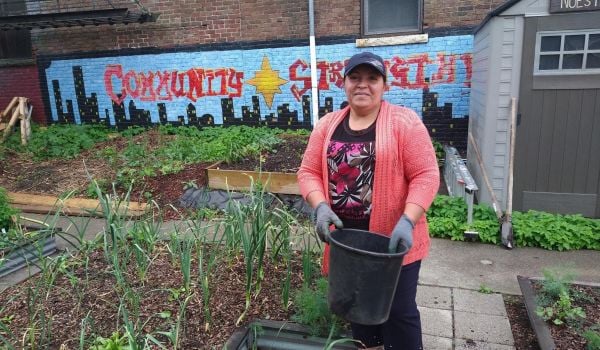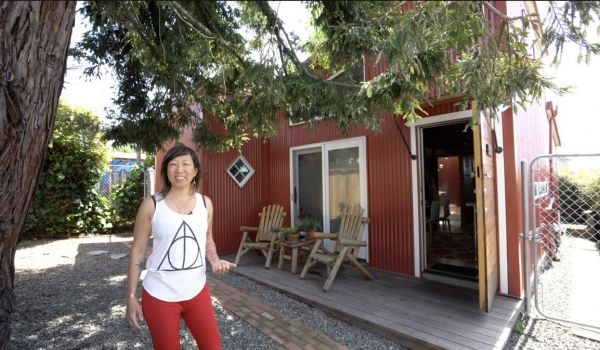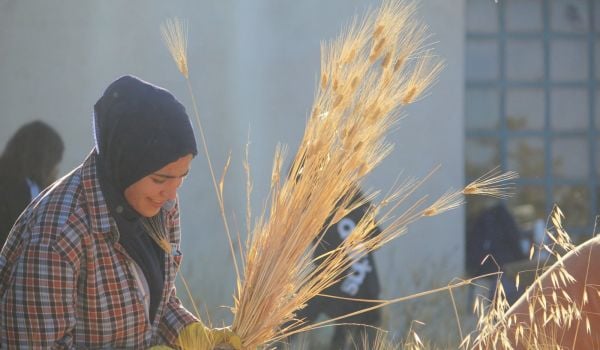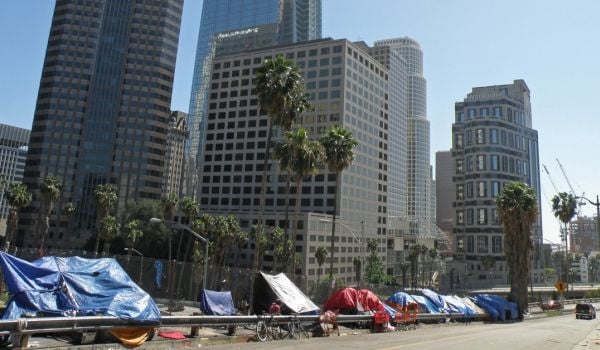Novella Carpenter’s new book, Farm City: The Education of an Urban Farmer chronicles her life on a makeshift farm in a tough neighborhood in Oakland, Cal. That city has long been known more for crime and blight than green space and farm animals. But Carpenter, the daughter of back-to-the-land hippies, started squat farming on an empty lot years ago, sowing seeds, planting trees and raising turkeys, rabbits and pigs. She hasn’t looked back since. I caught up with her on a recent trip to New York and we chatted about the book.
Jori Lewis: I want to know how you fell into this whole urban farming adventure in Oakland.
Novella Carpenter: My boyfriend and I had been doing urban farming. I had kept bees and chickens and done some vegetable gardening in Seattle for a number of years and so when I moved to Oakland I was kind of like: wow, I feel like living in California there’s something about – because there’s really no winter, these projects can really like just balloon out and develop. So, I started raising meat birds in Oakland and that’s kind of how it all happened. Then it basically spiraled from there.
JL: But did you really call it urban farming at first?
NC: We never called it anything in Seattle. It’s like we were weird people who had chickens and bees and there was no kind of identity surrounding it. I think California is really obsessed with identity and so I became obsessed with identity as well, but I also started encountering people who were doing similar things and they called it urban farming. I was like, wow! That’s what I’m doing! I’m urban farming.
JL: Throughout the book you write periodically about the history of urban farming. What were some of the more interesting places that you heard about that you were inspired by?
NC: Well, what happens a lot of times is I meet people who want to talk about urban farming [history]. They kind of say, “Yeah, there was that woman like 20 years ago who wrote Notes from a Suburban Farmer. “ So, I started just excavating. There was a book called The Inner Girl Urban House in Berkeley and this was in the 1970s. They were basically people who didn’t want to go back to the land like many hippies had gone back to the land and they decided to do urban farming in Berkley. So they had this whole elaborate system. They were raising tilapia, they were raising chickens, they were raising bees, and rabbits.
And so then you start looking at other things, like other ethnic groups. What’s interesting is that in the developing world, urban agriculture is huge. It’s what people do. I had a guy from Nigeria come over to my house and he was like, “I heard you have goats. I want to go see them.” I brought him into the backyard and the goats are all running up and down the stairs. It’s not a big backyard. He said, “It’s just like Nigeria.” And so I started to realize that it is an affectation a little bit for white people to talk about urban farming. But at the same time it’s a cultural identity for them in the same way.
As you start to unravel that history, you realize that urban farming has always existed. It’s not always been called urban farming, but there have always been people who have brought their animals, or their seeds, or their thing that made them culturally identified. Aztec people were urban farmers. They had these giant cities and they had corn growing there. It makes me feel really excited because then I feel like what I’m doing is not weird. And what I realized is that it’s a cultural construct to have this urban versus rural kind of idea because usually the two have always been together.
JL: You talk in your book a little bit about distinguishing yourself from the Berkeley hippies and the like. How did you distinguish yourself from them?
NC: I don’t know that I’m necessarily trying to distinguish myself from them. Because I think what I realized is that in some ways, wow, I’m doing similar things that my parents did, but it’s in a different era. It’s in a totally different time and the fact that I’m doing it in a city made me feel a little bit better about it, because I have access to all these different cultures and I can plug into the music scene or the art scene or whatever is going on in the city. So it is different. I think one of the things I totally agree with is the whole David Brooks bobo thing: these bohemian hippies who are bourgeois in this way. That’s really like a thing in Berkeley. What happens is it’s culturally alienating to people who are not wealthy, because it’s such a privileged perspective. Like I’m going to spend $20.00 a pound for some soup bones Crazy stuff happens in Berkeley at the farmers’ market, you know? So, for me it was really important to grow my own food and to raise my own meat and present an opposite, kind of more like a DIY perspective on how that can go down without being elitists. I discovered that there’s all these people in my neighborhood like the Vietnamese guys and the Yemeni storekeepers who have these major skills of farming — it’s just that nobody ever asked them. So there’s this really weird thing where people think that hippies are the greatest farmers, but it’s usually not true. The greatest farmers are people who have lived in developing countries where they had nothing and they had to figure out how to do it with nothing.
JL: You know, sometimes I think about growing vegetables and I’m actually a little put off because even though I know in the end I’ll save money, the initial investment is quite large. How did you manage to subsidize your urban farming?
NC: It’s true, the initial cost is a lot. You have to get the pots and all of this stuff. But I’m actually working on a “how to” urban farm book and it’s basically channeling the waste stream of the city in order to farm and save money. There are ways to do it. In New York there are places that sell containers and stuff. But I’ve noticed a lot of buckets alongside the road and at restaurants. The urban waste stream is insane in America. If you go to Mexico City, there is nothing like that. There would never be a bucket on a street corner, because someone is using it. They took it home and they’re growing plants in it. So I think we can learn those techniques so we just have to have an eye open for these opportunities. If there is a race track, if there is any kind of stables like those horses that are driving the carts around, you could access that and compost the horse manure. So, there are ways to do it on the cheap. You just have to be resourceful and have an attitude of trying to be sustainable.
JL: But what about the animals? You talk in your book a little bit about that since you live in the city, it’s not like these animals can graze. So you have to pay for feed for them.
NC: I did initially and this is why this was “an education of an urban farmer.” The first animal I raised was a turkey, and I poured like $100.00 worth of poultry feed down his throat. He was a voracious eater and I loved how that turkey tasted, but if I did a cost analysis, that made no sense. So what we started to do was dumpster dive for the animals. Now the chickens and the rabbits eat dumpster food so we’re able to find all this great organic lettuce in dumpsters. All the animals eat that. We raised two pigs and they were fed exclusively on dumpster scraps so we spent not one dime on feeding them, but the time thing became a major thing. So I’m not trying to present a rosy portrait, necessarily. It is a lot of work and it can be disgusting, especially the pigs. But if you’re really motivated, it’s possible.
JL: This is a really good idea, actually. But if more people were to take your dumpster diving approach, would there be enough dumpsters to dive?
NC: It’s not for everybody. You can’t believe how much stuff is in the dumpster and I’m only going to one store. There is so much excess food out there. The other thing is farmers have a huge amount of waste as well, so you don’t even have to go to a dumpster if you go the farmers market at the end of the day.
JL: One of the big things you talk about in your book is that being an urban farmer, you don’t own your land. And so the developers are always encroaching threatening to take away your empty lot.
NC: Well, the book was written basically from 2005 to 2007, which was probably the most excessive time in the United States of America ever. One of the things I’ve noticed as we go back to the dumpsters is that there is less stuff. For instance, we fed our pigs peaches. We would find dumpsters filled with peaches — literally filled. And now with the recession, that’s happening less often. So while I was writing the book it was really during the fattest times and now those times are kind of ending, especially in California. There is a fear that the person who owns the land will come along and say, “No. You can’t do this anymore.” So it’s a worry. It’s a concern so since prices are so low right now, we’re seriously looking at buying some property in downtown Oakland and setting up. I kind of have like a ghetto farm fantasy where I would have this giant farm in the middle of the city and it would be a demonstration site and we’d do tours for kids and it would just be like this whole educational center. That’s my five-year plan, pretty much.
JL: So, what’s growing in the garden now?
NC: Well for the book we had this giant party at this restaurant of the guy who turned my pigs into prosciutto. So, we had this enormous party and most of my garden is basically ransacked from that harvest. It was the potatoes and carrots and everything. But right now the tomatoes are coming on, the corn, the cucumbers. It’s high summer. My goats gave birth in May so we’re having the whole surplus of milk, which is really great. We’re going to start harvesting honey in a couple of weeks too.








_600_350_80_s_c1.jpeg)






